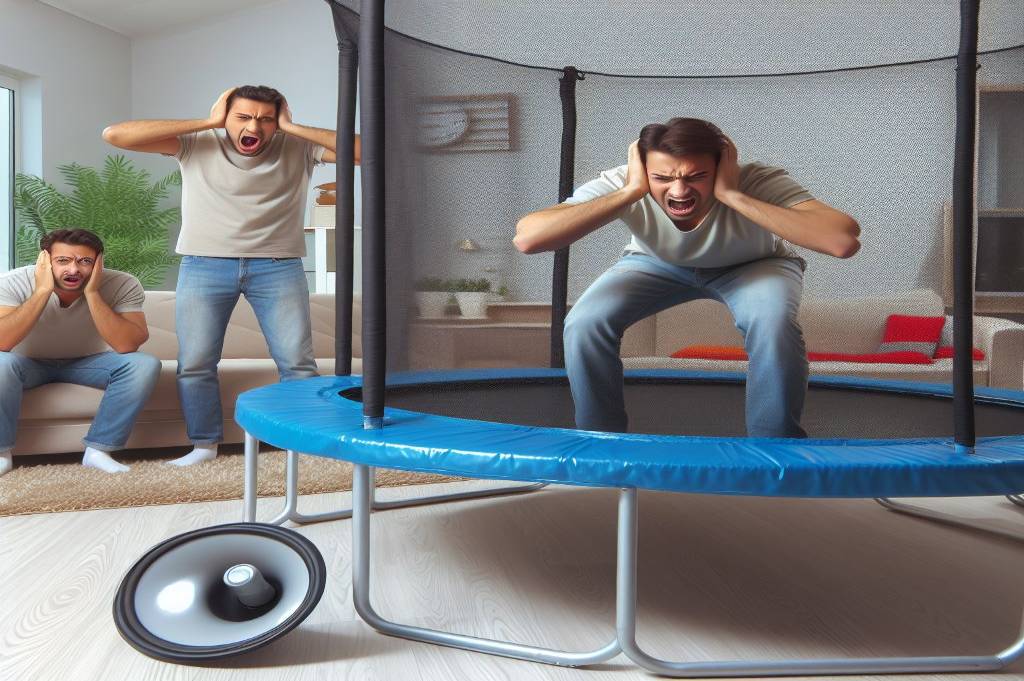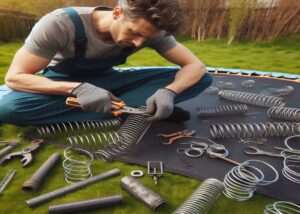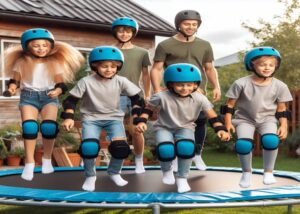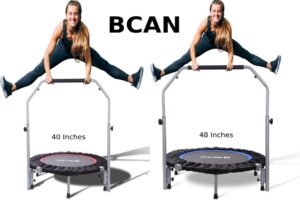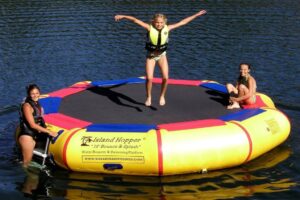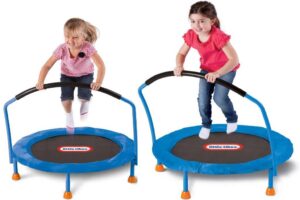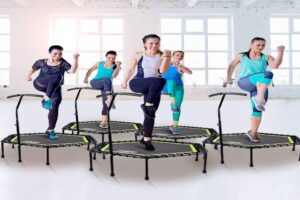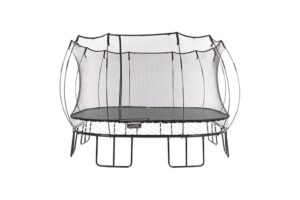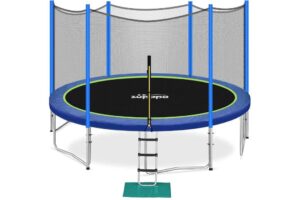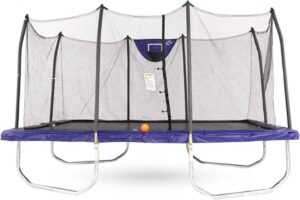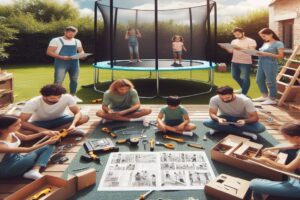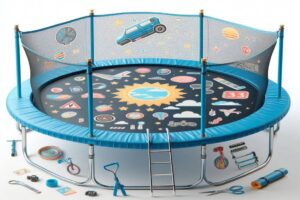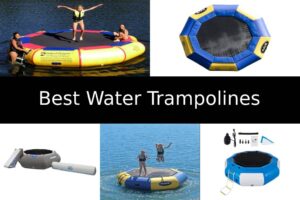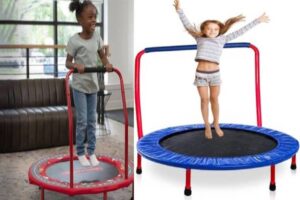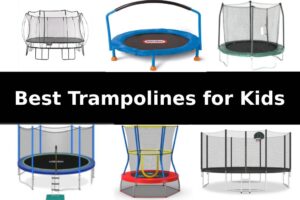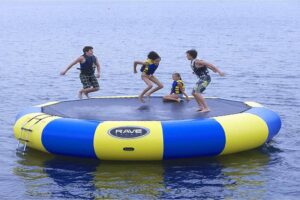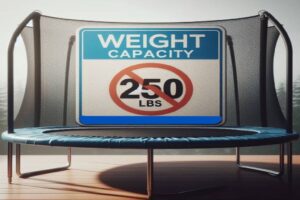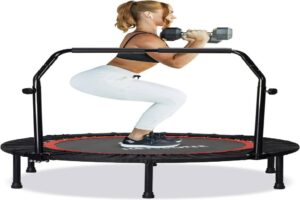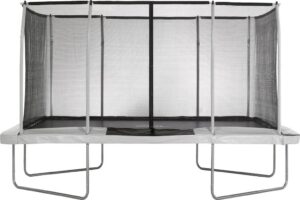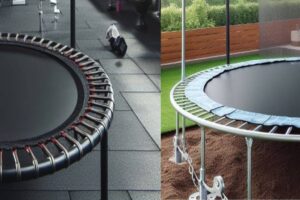Introduction
Trampoline noise reduction is the key focus of our guide. Trampolines, while a source of joy and excitement, can often generate unwanted noise.
The thumping and squeaking from jumping might not only bother you but also bug your neighbors. In this guide, we’ll figure out how to make your trampoline quieter so you can have fun without causing a disturbance.
Trampoline noise can be annoying, especially when you’re trying to relax. It’s important to tackle this issue so you can enjoy your trampoline without bothering the people nearby.
Besides keeping the peace, a quieter trampoline just makes the whole bouncing experience better. It lets you have more fun without being too loud. And, by finding ways to quiet down your trampoline, you’re also being a good neighbor.
This guide is here to help you make your trampoline quieter and have a blast without causing a racket. Let’s dive into strategies for trampoline noise reduction.
Understanding the Causes of Trampoline Noise
Ever wondered why your trampoline seems to have its own sound effects? We’re going to discover the reasons behind trampoline noise. Whether it’s the springs, the frame, or the way you bounce.
-
The Role of Springs and Frame icn Trampoline Noise
The springs and frame of your trampoline work together to create that lively bounce. While these components bring joy to your jumps, they also play a significant role in the trampoline noise that accompanies the fun.
-
Impact of User Exercises on Trampoline Noise Levels
Ever noticed how the way you bounce on a trampoline can create its own set of sounds? Your exercises on the trampoline directly influences the noise levels. Whether it’s the landing technique, jumping style, or playful movements, each action contributes to the unique soundtrack of your jumping session.
-
Common Complaints from Neighbors
It’s essential to consider the perspective of our neighbors when it comes to trampoline noise.
We explore their common complaints they might have about the sounds coming from our bouncing adventures. By understanding their concerns, we can take steps to minimize any disruptions, fostering a more harmonious relationship within the community.
Assessing Your Trampoline Assembly and Setup
To embark on the path of a quieter and more enjoyable trampoline experience, a critical first step is to assess your trampoline assembly and setup.
Here, we’ll guide you through the process of evaluating key elements such as the age, condition, and potential noise sources of your trampoline.
-
Evaluating Trampoline Age and Condition
Understanding the age and condition of your trampoline is fundamental to ensuring its continued performance and safety.
By recognizing signs of wear and tear, you’ll gain valuable insights into areas that may require attention. This proactive assessment not only enhances the safety of your jumping sessions but also allows you to address any potential issues before they become significant.
Identifying potential issues early on allows you to address them before they increase. Whether it’s replacing worn-out springs, patching up a tear in the jumping mat, or tightening loose bolts, taking prompt action ensures a safer and more reliable trampoline.
-
Checking for Loose Components
Start your inspection by examining the frame, legs, and all connecting joints. Pay special attention to the nuts and bolts securing the frame – these are key components that hold everything together.
Check each spring for proper tension and secure attachment. Loose or damaged springs can affect the even distribution of weight, potentially leading to uneven bouncing or, in extreme cases, accidents. Replace any worn-out or damaged springs immediately.
Inspect the jumping mat for tears or signs of wear. Ensure that it is securely attached to the frame with intact stitching. A loose or damaged jumping mat can compromise the overall stability and safety of the trampoline.
-
Identifying Potential Trampoline Noise Sources
Trampoline noise can be more than just an inconvenience; it might also affect the enjoyment of your bouncing sessions and the peace of your surroundings.
Begin your exploration by closely inspecting the springs and frame. Loose or rusty springs, as well as worn-out frame components, can contribute significantly to trampoline noise. Tightening bolts and replacing worn parts can work wonders in minimizing these trampoline noise sources.
The jumping mat can also be a source of unexpected sounds. Check for tears or areas of wear, as these can create additional trampoline noise during bouncing. Repair or replace the jumping mat as needed to ensure a quieter trampoline.
Consider lubricating moving parts, especially if you notice squeaks or creaks during use. Applying a suitable lubricant to hinges and joints can significantly reduce friction and noise, creating a smoother bouncing experience.
If your trampoline features an enclosure, inspect the components for any loose or damaged parts. The netting, poles, and attachment points should be secure to minimize any potential trampoline noise caused by movement.
Sometimes, the trampoline noise is not just about the trampoline itself but also about how it’s used. Encourage users to be mindful of their jumping techniques, landing softly, and avoiding unnecessary stomping, which can amplify noise.
Incorporate a regular maintenance routine that includes inspecting and addressing potential trampoline noise sources. This proactive approach ensures a consistently quiet and enjoyable trampoline experience.
DIY Trampoline Noise Reduction Techniques

If the joyful bounce of your trampoline is being drowned out by unwanted noise, fear not.
Here, we’ll explore some simple yet effective do-it-yourself (DIY) trampoline noise reduction techniques. Say goodbye to the symphony of squeaks and thuds and hello to a quieter, more enjoyable trampoline experience.
-
Adding Foam Padding to Springs
One effective way to reduce trampoline noise is by adding foam padding to the springs. Secure foam pieces around each spring to dampen the impact and muffle the sound. Including this simple addition can make a meaningful change in reducing sound disturbance.
When it comes to trampoline padding, the material matters, materials known for durability and resistance to weather elements. Common materials include polyethylene, PVC, and vinyl. These not only provide excellent protection.
The thickness of the padding directly impacts its ability to absorb impact and protect jumpers. A thicker pad provides better shock absorption and overall safety during use.
Since trampolines are often placed outdoors, exposure to sunlight is inevitable. Choose padding materials with UV-resistant properties to prevent fading, deterioration, and loss of protective qualities over time.
Outdoor trampolines are susceptible to exposure to rain and other weather conditions. Padding materials that are water-resistant to prevent saturation, mould growth, and the compromising of protective qualities. Water-resistant padding ensures a safe and reliable jumping surface.
-
Lubricating Moving Parts: for Trampoline Noise Reduction
Lubricating the moving parts of your trampoline including hinges and joints, a simple yet effective solution to ensure a smooth and noise-free bouncing experience.
Selecting the appropriate lubricant is crucial. Silicone-based lubricant known for its long-lasting properties and resistance to water. Silicone lubricants are effective in reducing friction without attracting dirt or debris, ensuring a clean and efficient lubrication.
Clean the trampoline thoroughly to remove any dirt, debris, or old lubricant that may interfere with the new application. A clean surface ensures optimal adherence of the lubricant to the moving parts.
Using a cloth or sponge, apply the silicone lubricant directly to the hinges, joints, and any other moving parts. Ensure even coverage, working the lubricant into the components to create a smooth and friction-free surface.
After applying the lubricant, move the parts back and forth to distribute the lubricant evenly. This ensures that every nook and cranny of the moving components receives the benefits of the lubrication.
Incorporate lubricating the moving parts into your regular trampoline maintenance routine. Aim for this procedure at least twice a year or more frequently if your trampoline sees heavy use or is exposed to challenging weather conditions.
-
Tightening Bolts and Screws: For Trampoline Noise Reduction
As trampolines endure the boundless energy of bouncers and the elements of weather, bolts and screws can gradually loosen. This loosening not only compromises the structural integrity of your trampoline but may also contribute to annoying trampoline noise during use.
The crucial practice of tightening bolts and screws on your trampoline. This routine maintenance step not only ensures stability but also contributes to a safer and more enjoyable bouncing experience.
Before embarking on the tightening journey, ensure you have the necessary tools at hand. A wrench or socket set compatible with your trampoline’s bolts and screws is essential for effective tightening.
Inspect your trampoline, identifying all bolts and screws that might have loosened over time. Pay attention to the frame, legs, and any connecting joints.
While inspecting, take note of any signs of wear and tear on the bolts and screws. If you identify damaged or worn-out fasteners, consider replacing them with new ones to maintain optimal stability.
Start the tightening process systematically. Begin with one section of the trampoline, tightening each bolt or screw snugly before moving on to the next. Ensure even tension across all components for uniform stability.
Pay special attention to the frame and legs, as these components bear the brunt of the bouncing activity. Tightening the bolts and screws on the frame and legs is paramount for maintaining the overall stability of your trampoline.
Incorporate tightening bolts and screws into your regular trampoline maintenance routine.
Aim for this procedure at least twice a year or more frequently if your trampoline sees heavy use or is exposed to challenging weather conditions.
-
Placing Rugs or Mats Underneath: For Trampoline Noise Reduction
While trampolines offer a thrilling bounce, the constant impact can take a toll on joints and create unwanted noise. Placing rugs or mats underneath serves as an additional cushioning layer, offering a more forgiving surface for landings and minimizing the trampoline noise.
Selecting the right materials for your rugs or mats is crucial. Weather-resistant, durable options that can withstand exposure to the elements if your trampoline is placed outdoors. Rubber mats or outdoor rugs are excellent choices for this purpose.
Before placing the rugs or mats, measure the area beneath your trampoline to ensure a proper fit.
If your trampoline is set up on a hard surface like concrete or pavement, rugs or mats act as a buffer, absorbing some of the impact and reducing stress on joints. This additional layer of cushioning also contributes to a more comfortable and forgiving landing.
Beyond comfort, rugs or mats underneath your trampoline can help dampen noise. The added cushioning absorbs some of the impact sound, contributing to a quieter bouncing experience. This is especially beneficial if your trampoline use may disturb neighbors.
Incorporate a regular cleaning routine for the rugs or mats to prevent the accumulation of dirt or debris. Clean surfaces provide optimal cushioning and ensure a hygienic environment for bouncing.
-
Enclosure Modifications: For Trampoline Noise Reduction
Trampoline enclosures are not just safety barriers; they also play a role in the noise of your bouncing haven. By focusing on specific modifications, you can actively reduce the noise generated during each bounce, creating a more peaceful environment for both jumpers and neighbors.
Begin the noise reduction journey by inspecting the enclosure netting. Check for any loose or sagging areas and reinforce them to create a taut surface. A properly tensioned netting absorbs some of the impact noise during jumps.
Consider attaching noise-absorbing material, such as foam padding, to the enclosure poles. This modification not only enhances safety by providing a softer surface in case of collisions but also contributes to noise reduction, creating a quieter bouncing experience.
Check the attachment points where the netting connects to the frame and ensure they are securely fastened. Tight attachment points minimize vibrations and reduce the potential for noise caused by movement.
Assess the design of your trampoline enclosure and consider whether any structural adjustments could contribute to noise reduction. Enclosures with sturdy, well-designed components tend to generate less noise during use.
When making modifications or replacements, choose materials known for their noise-reducing properties. Some fabrics and foams are specifically designed to absorb and dampen sound, providing a quieter environment for bouncing.
Incorporate a regular maintenance routine for the enclosure, checking for any wear, tear, or loose components. Addressing issues promptly not only maintains safety but also contributes to a quieter trampoline experience.
-
User Education: For Trampoline Noise Reduction
While trampolines are designed for fun and excitement, the way users interact with the bouncing surface can significantly influence noise levels. User education plays a pivotal role in fostering awareness and encouraging practices that reduce the impact on both the trampoline and its surroundings.
Educate trampoline users, especially children, on the importance of gentle landing techniques. Encourage them to land softly with slightly bent knees, absorbing the impact gradually. A softer landing minimizes the force transferred to the trampoline, reducing overall noise.
Make users aware that stomping or engaging in rough play on the trampoline amplifies noise levels. Discourage these behaviors and encourage a more controlled and considerate approach to bouncing. This ensures a quieter and safer experience for everyone.
Promote controlled bouncing movements by emphasizing the importance of balance and coordination. Users should be mindful of their body movements, avoiding erratic jumps or sudden shifts that can contribute to noise generation.
Encourage users to focus their jumping activities toward the center of the trampoline. Jumping in the middle distributes the force more evenly across the surface, minimizing vibrations and noise compared to concentrated jumping near the edges.
Educate users about the impact of noise on their surroundings, emphasizing the importance of being good neighbors. A mindful approach to trampoline use not only enhances the user’s experience but also contributes to a positive relationship with those nearby.
In conclusion, DIY trampoline noise reduction techniques offer a practical and budget-friendly solution to the common issue of trampoline noise. By implementing these simple strategies, you can enjoy a quieter and more peaceful bouncing experience. Join us in the next section as we explore additional tips and tricks to elevate your trampoline adventures. Happy bouncing, noise-free!
Advanced Solutions for Trampoline Noise Reduction
While basic modifications can significantly reduce trampoline noise, advanced solutions take it a step further. These techniques target specific components and leverage advanced materials to create an environment where the only sound is the gentle whisper of bouncing.
-
Install Noise-Dampening Mats
Consider investing in specialized noise-dampening mats designed explicitly for trampolines. These mats absorb impact noise at a higher efficiency compared to standard materials, providing an advanced layer of trampoline noise reduction.
-
Upgrade Springs with Noise-Reducing Covers
Explore the option of upgrading your trampoline springs with noise-reducing covers. These advanced covers not only protect springs from wear but also minimize vibration and help in trampoline noise reduction during each bounce, creating a smoother and quieter experience.
-
Utilize Anti-Vibration Pads
You can use anti-vibration pads placed beneath trampoline legs to absorb shock and vibration, preventing them from transmitting to the ground. These advanced pads are designed to dampen vibrations more effectively, contributing to a quieter and more stable bouncing platform.
-
Invest in High-Tech Springs
Consider upgrading to high-tech springs engineered specifically for trampoline noise reduction. These advanced springs often incorporate innovative materials and designs that minimize friction and sound, creating a virtually silent bouncing experience.
-
Explore Enclosure Innovations
Look into advanced enclosure designs that incorporate noise-reducing features. Some enclosures utilize specialized materials and construction techniques to dampen the impact noise generated by bouncing, enhancing the overall quietness of the trampoline.
-
Implement Suspension Systems
Advanced suspension systems, inspired by technologies used in professional trampolines, can be adapted for residential use. These systems are designed to absorb impact more efficiently, resulting in a smoother bounce and reduced noise levels.
-
Engage Professional Installation
Consider engaging professional installers experienced in advanced trampoline noise reduction techniques. Their expertise can ensure that every component, from springs to enclosures, is optimized for minimal noise generation.
-
Explore Aerodynamic Design Elements
Incorporate aerodynamic design elements into your trampoline setup. These advanced features minimize air resistance during jumps, reducing the turbulence that can contribute to trampoline noise generation.
Lifestyle Adjustments for Quieter Trampoline Use
Welcome to our guide on making lifestyle adjustments for a quieter trampoline experience!
While trampolines offer endless fun, they can sometimes create noise that disrupts the tranquility of your surroundings.
Here, we’ll explore simple yet effective lifestyle changes that can help minimize trampoline noise, ensuring a more peaceful bouncing environment for you and your neighbors. Let’s dive in!
-
Setting Specific Bouncing Hours
By setting specific bouncing hours, trampoline owners can ensure that their bouncing activities align with quieter periods of the day, such as mid-morning or early afternoon.
This not only allows for uninterrupted enjoyment of the trampoline but also demonstrates consideration for neighbors and their need for peace and quiet during certain times.
By communicating these designated hours to household members and neighbors, trampoline owners can create a harmonious balance between their recreational activities and the surrounding environment, fostering positive relationships within the community.
-
Educating Family Members about Noise Impact
By educating family members about the potential disturbance caused by loud bouncing, trampoline owners can encourage them to adopt quieter play techniques, such as landing softly and avoiding roughhousing.
This proactive approach not only minimizes noise disruptions but also fosters a sense of responsibility and consideration for others. By involving family members in discussions about noise management and setting clear expectations for behavior on the trampoline, trampoline owners can create a cooperative environment where everyone contributes to a quieter and more enjoyable bouncing experience for all.
-
Considering Neighbor-Friendly Alternatives
Consider engaging in quieter recreational pursuits, such as indoor trampoline parks or other indoor activities, during times when noise levels need to be minimized.
By seeking out neighbor-friendly alternatives, trampoline owners can enjoy recreational activities without worrying about causing disturbances to those nearby. This approach demonstrates consideration for neighbors’ peace and quiet while still allowing trampoline enthusiasts to indulge in their favorite pastime.
Additionally, exploring alternative activities can offer new and exciting opportunities for family fun and bonding in a controlled environment. Overall, considering neighbor-friendly alternatives is a proactive and considerate approach to managing noise levels and maintaining positive relationships within the community.
Maintenance Tips for Long-Term Noise Control
Maintaining long-term noise control for your trampoline requires diligence and care.
By establishing a regular inspection routine, keeping your trampoline clean, tightening bolts and fasteners, investing in quality materials, educating users, and performing seasonal maintenance, you can ensure that your bouncing haven remains a peaceful and enjoyable retreat for years to come.
Happy bouncing, and may your trampoline continue to provide endless hours of quiet entertainment!
-
Regular Inspection Routine
Establish a routine inspection schedule to regularly assess the condition of their trampoline and its components.
By inspecting the trampoline frame, springs, padding, and enclosure netting on a consistent basis, potential issues such as wear, tear, or damage can be identified early and addressed promptly. This proactive approach not only ensures the safety and longevity of the trampoline but also contributes to minimizing noise disruptions.
By staying vigilant and conducting regular inspections, trampoline owners can maintain a quiet and enjoyable bouncing environment for themselves and their neighbors.
-
Seasonal Maintenance Checklist
Prepare your trampoline for seasonal changes to ensure continued noise control and longevity. As the weather shifts throughout the year, perform a series of maintenance tasks to protect their equipment and preserve its functionality.
This checklist may include securing or storing loose components, applying lubricant to moving parts, inspecting weather-resistant features for wear or damage, and ensuring that the trampoline is ready to withstand the elements.
By proactively addressing seasonal maintenance needs, you can minimize noise disruptions and extend the lifespan of their equipment, ensuring many seasons of enjoyable bouncing ahead.
-
Revisiting Trampoline Noise Reduction Measures Over Time
Revisit the trampoline noise measures and evaluate their effectiveness over time.
This involves identifying any new sources of noise or areas where noise control measures may have become less effective due to wear or changes in usage patterns.
By staying vigilant and proactive, you can address emerging noise issues promptly and fine-tune their noise reduction strategies as needed.
This ongoing process ensures that the trampoline remains a quiet and enjoyable environment for bouncing, maintaining harmony with neighbors and the surrounding community.
Conclusion
In conclusion, our journey through the realm of trampoline noise reduction has been nothing short of transformative.
By delving into effective strategies and techniques, we’ve uncovered the power to silence the once-boisterous bounce of our trampolines. Through diligent implementation of lifestyle adjustments, regular maintenance routines, and proactive user education, we’ve not only minimized trampoline noise but also cultivated a culture of mindful bouncing.
As we reflect on the accomplishments of our noise reduction endeavors, it’s evident that the key to a harmonious bouncing experience lies in our commitment to trampoline noise reduction.
By integrating noise-reducing measures into our bouncing routines and embracing the principles of responsible bouncing, we’ve created a sanctuary of tranquility within our own backyard.
As we bid farewell to this guide, let us carry forward the lessons learned and continue to champion the cause of trampoline noise reduction in our communities.
Together, we can ensure that every bounce is a celebration of silence, where the joy of bouncing is amplified by the absence of noise. Here’s to the future of trampoline noise reduction, where silence reigns supreme and every bounce is a testament to our dedication to quiet enjoyment.
Related posts:
- Trampoline Safety Tips – Jumping for Joy without the Risk
- Trampoline Assembly Excellence: Your Comprehensive Step-by-Step Guide to Bouncing Bliss!
- Trampoline Hole Repair Guide: Masterful Fixes for Unleashing Bouncing Power!
- The Ultimate Trampoline Measurements Guide: Elevate Your Bouncing Experience
- Indoor vs. Outdoor Trampolines: Dominate Your Bounce
